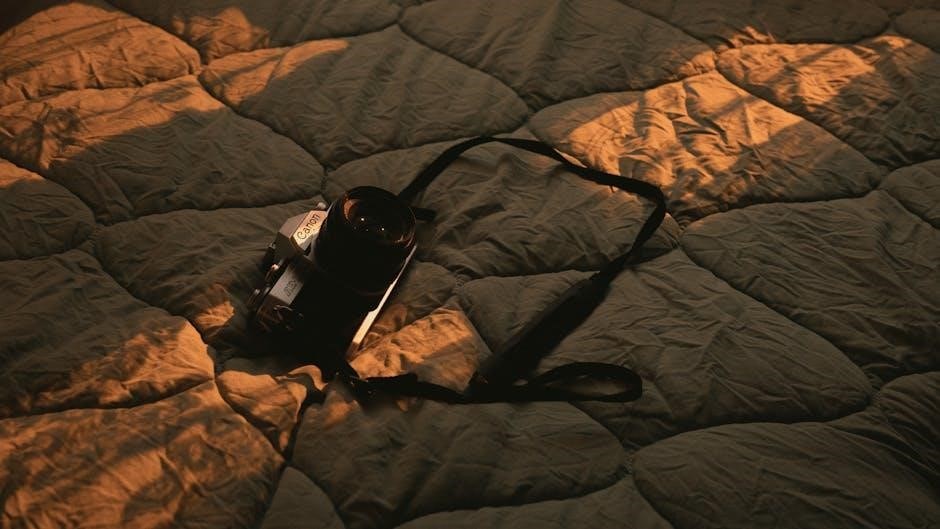Canon EOS R8 Manual: A Comprehensive Guide
Welcome to your comprehensive guide to mastering the Canon EOS R8! This resource will navigate you through the camera’s functionalities. We’ll explore everything from basic operations to advanced settings. Unlock your R8’s full potential and capture stunning images with confidence.
Embark on a journey to unlock the full potential of your Canon EOS R8 with this comprehensive guide. Designed to cater to both novice and experienced photographers, this manual serves as your indispensable companion in mastering the intricacies of this powerful camera. The Canon EOS R8 combines cutting-edge technology with user-friendly design, offering a gateway to capturing breathtaking images and videos.

This manual begins with a foundational overview of the camera’s features, guiding you through initial setup and basic operations. It then progressively delves into advanced functionalities, offering step-by-step instructions and practical tips to enhance your photographic skills. Whether you’re exploring the camera’s various shooting modes, customising settings to suit your specific needs, or troubleshooting common issues, this guide provides clear, concise explanations and solutions.
Furthermore, this manual incorporates insights gleaned from experienced Canon EOS R8 users. You’ll discover preferred settings and techniques that can significantly improve your workflow and creative output. Consider this manual as more than just a set of instructions; it’s a curated collection of knowledge and expertise designed to empower you on your photographic journey.
Basic Operations: Getting Started with Your R8
Let’s begin your Canon EOS R8 adventure by understanding the fundamental operations of your new camera. This section is designed to provide a clear and concise pathway for getting started, ensuring you’re comfortable with the basics before diving into more advanced features. First, we’ll cover the essential steps of setting up your camera. This includes inserting the battery and memory card, crucial steps before powering on your R8.

Next, learn about the primary controls. Familiarize yourself with the power switch, shutter button, dials, and mode selection. We’ll explain the function of each button and dial. Furthermore, we’ll explore basic image capture techniques. Learn how to hold the camera correctly for stability, and focus effectively using the autofocus system.
Mastering these basics is essential for a solid foundation in photography. Once you’re familiar with these initial steps, you’ll be ready to explore the R8’s diverse shooting modes. We will also discuss the menu system, allowing you to adjust settings like ISO, white balance, and image quality. This section aims to transform you from a beginner to a confident user.
Exploring the Advanced User Guide
Now that you’ve grasped the basics, it’s time to delve deeper into the Canon EOS R8’s capabilities with the Advanced User Guide. This comprehensive resource unlocks the full potential of your camera, providing detailed explanations of every feature and setting. The Advanced User Guide is more than just a manual; it’s a key to mastering advanced photographic techniques. This allows you to capture images that truly reflect your artistic vision.
Within its pages, you’ll find in-depth tutorials on complex topics such as advanced autofocus modes. Also, explore custom white balance, and sophisticated metering options. Learn how to use the R8’s custom functions to tailor the camera to your specific shooting style. The Advanced User Guide also covers connectivity features, explaining how to seamlessly transfer images. You can also remotely control your camera via Wi-Fi and Bluetooth.
Furthermore, it provides detailed troubleshooting advice. This ensures you can resolve common issues and keep your camera performing optimally. Whether you’re a seasoned photographer or an ambitious enthusiast, the Advanced User Guide is an indispensable tool. It provides you with the knowledge and skills to elevate your photography with the Canon EOS R8. Embrace the challenge and unlock your creative potential.
Key Topics Covered in the R8 Manual
The Canon EOS R8 manual is structured to provide a comprehensive understanding of the camera’s features and functionalities. It guides users from initial setup to advanced techniques, ensuring a smooth learning curve for photographers of all levels. A crucial section delves into the camera’s various shooting modes, explaining their specific applications and how to optimize them for different scenarios. You’ll learn about the intelligent auto mode, scene modes, and creative filters, alongside the more advanced aperture priority, shutter priority, and manual modes.
The manual dedicates significant attention to the autofocus system, detailing the various AF modes, focus area settings, and subject tracking capabilities. Understanding these aspects is critical for capturing sharp and well-focused images, especially in dynamic shooting situations. Furthermore, the manual provides in-depth explanations of the camera’s metering modes, white balance settings, and ISO sensitivity, empowering users to achieve accurate exposure and color rendition in diverse lighting conditions.
Beyond the fundamental settings, the R8 manual explores advanced features such as custom functions, allowing photographers to personalize the camera’s operation to suit their preferences. It also covers connectivity options, including Wi-Fi and Bluetooth, enabling seamless image transfer and remote control. Finally, troubleshooting tips are provided to address common issues and ensure a smooth shooting experience.
Understanding Camera Settings and Menus
Navigating the Canon EOS R8’s settings and menus is essential for unlocking its full potential. The camera’s menu system is logically organized, dividing settings into categories such as shooting, playback, setup, custom functions, and “My Menu.” Understanding this structure is the first step towards efficient camera operation. The shooting menu allows you to control fundamental image parameters like image quality, aspect ratio, and file format (JPEG, RAW, or both). Exposure settings, including aperture, shutter speed, ISO, and exposure compensation, are also managed within this section.
The playback menu provides options for reviewing images, protecting them from accidental deletion, rating them, and performing basic editing tasks. The setup menu is where you’ll find settings related to the camera’s overall operation, such as date and time, language, display brightness, and Wi-Fi/Bluetooth connectivity. Custom Functions offer a high degree of personalization, enabling you to tailor the camera’s behavior to your specific shooting style.
“My Menu” is a customizable section where you can store frequently used settings for quick access. Mastering the menu system allows you to quickly adjust camera parameters in response to changing shooting conditions, ensuring you capture the perfect shot every time. Don’t hesitate to experiment with different settings to discover how they affect your images.
Tips and Tricks for Optimal Performance
To truly maximize your Canon EOS R8’s performance, consider these essential tips and tricks. Firstly, master the autofocus system; experiment with different AF area modes to suit various subjects and shooting scenarios. Utilize back-button focusing for greater control over focus acquisition. Customize your camera’s buttons and dials to streamline your workflow, placing frequently used settings at your fingertips. Shoot in RAW format to preserve maximum image data for post-processing flexibility.
Regularly update your camera’s firmware to benefit from performance enhancements and bug fixes. Clean your sensor periodically to prevent dust spots from appearing in your images. Invest in high-quality lenses to maximize the image quality potential of the R8’s sensor. Understand the exposure triangle (aperture, shutter speed, ISO) and how each element affects your images.
Practice different shooting techniques, such as panning and using fill flash, to expand your creative repertoire. Learn to read histograms to ensure proper exposure in various lighting conditions. Take advantage of the R8’s in-body image stabilization (IBIS) to capture sharper images at slower shutter speeds. Finally, always carry extra batteries and memory cards to avoid interruptions during important shoots. By implementing these tips, you’ll unlock the full potential of your Canon EOS R8.
Troubleshooting Common Issues
Encountering issues with your Canon EOS R8? Let’s address some common problems. If your camera is not turning on, ensure the battery is properly charged and correctly inserted. Check the battery contacts for any dirt or corrosion. If the camera freezes or becomes unresponsive, try removing and reinserting the battery to perform a hard reset.
Experiencing blurry images? Verify that your lens is properly attached and clean. Ensure your shutter speed is fast enough to prevent motion blur, especially in low light. Check your focus settings and ensure the autofocus is locking onto your intended subject; If you are having difficulty downloading files from your camera to your computer, make sure that the cable is properly connected to the camera and computer.
If you notice excessive noise in your images, especially at high ISO settings, try enabling noise reduction features in the camera’s menu or using noise reduction software during post-processing. Should you encounter error messages on the LCD screen, consult the user manual for specific troubleshooting steps related to each code. When all else fails, contacting Canon’s support team or visiting an authorized service center can provide further assistance in resolving persistent issues.
Downloading and Accessing the Manual (PDF)
Accessing the Canon EOS R8 manual is straightforward. The most convenient way is to download the PDF version from the official Canon support website. Navigate to Canon’s website and search for the EOS R8 support page. Here, you’ll find drivers, software, and manuals available for download. Look for the “Manuals” section and select the “EOS R8 Advanced User Guide.”
Click on the PDF link to initiate the download. Save the file to your computer or mobile device for offline access. The PDF manual allows you to easily search for specific topics, zoom in on diagrams, and print pages as needed. Alternatively, Canon may offer an online version of the manual, accessible through a web browser.
This online guide provides a similar interactive experience to the PDF, with the added benefit of hyperlinks and multimedia content. Explore both options to determine which format best suits your learning style. Remember to check for updates to the manual periodically, as Canon may release revised versions with additional information or corrections. Having the manual readily available ensures you can quickly resolve any questions or issues that arise while using your EOS R8.
Finding Additional Support and Resources

Beyond the Canon EOS R8 manual, a wealth of resources exists to enhance your understanding and usage of the camera. Canon’s official website is your primary hub, offering FAQs, troubleshooting guides, and firmware updates. Explore the support section for articles addressing common issues and providing step-by-step solutions.

Consider joining online forums dedicated to Canon EOS R8 users. These communities provide a platform to connect with fellow photographers, share experiences, and seek advice. Websites such as RFshooters.com and Canon-specific forums offer valuable insights and tips. YouTube is another excellent resource, with numerous tutorials and reviews covering various aspects of the R8.
Look for channels specializing in photography and Canon products. Many offer in-depth explanations of camera settings and techniques. Don’t overlook local photography clubs and workshops. These provide hands-on learning opportunities and personalized guidance. Remember to check Canon’s social media channels for announcements, tips, and inspiration. By leveraging these diverse resources, you can continuously expand your knowledge and skills, maximizing your enjoyment and effectiveness with the Canon EOS R8.

Leave a Reply
You must be logged in to post a comment.